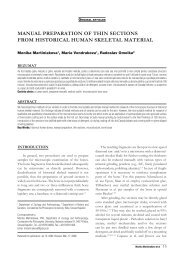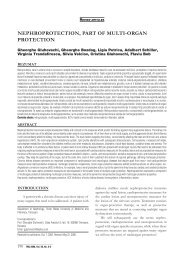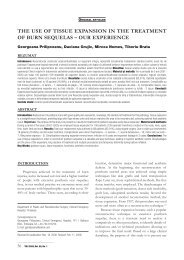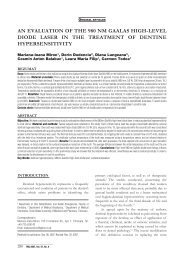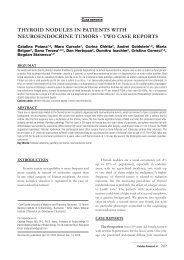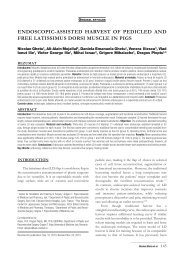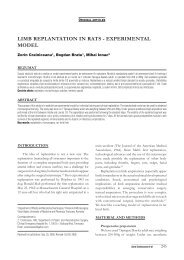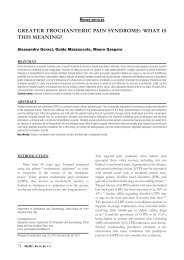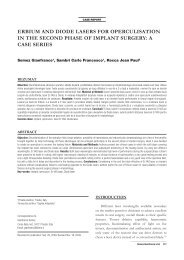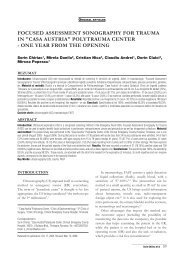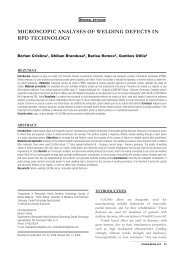MEtallographic aspEcts of wEldings bEtwEEn orthodontic rings and ...
MEtallographic aspEcts of wEldings bEtwEEn orthodontic rings and ...
MEtallographic aspEcts of wEldings bEtwEEn orthodontic rings and ...
Create successful ePaper yourself
Turn your PDF publications into a flip-book with our unique Google optimized e-Paper software.
a<br />
b<br />
c<br />
Figure 1. Orthodontic device <strong>of</strong> type Quad Helix: a. situated on the cast;<br />
b. detached from the cast; c. ring-arch welding detail<br />
The coming out <strong>of</strong> a new series <strong>of</strong> devices like<br />
MIA (Mobile Intraoral Arch) satisfies the patients<br />
not only <strong>orthodontic</strong> but also esthetically. We<br />
insisted on the Quad Helix, an <strong>orthodontic</strong> device<br />
with <strong>orthodontic</strong> <strong>rings</strong>, on which an oral arch is<br />
attached. 5,9 The <strong>orthodontic</strong> <strong>rings</strong> are placed on the<br />
molars <strong>and</strong> the palatal or lingual arch is welded on<br />
these <strong>rings</strong>.<br />
The arch, which is orally placed, moves<br />
symmetrically or asymmetrically various groups <strong>of</strong><br />
teeth <strong>and</strong> can solve complicated anomalies (maxillary<br />
disjunction, open bite, posterior cross bite), without<br />
being noticed by the entourage. From this group <strong>of</strong><br />
devices, we present a QUAD HELIX/CRIB variant,<br />
created at the Orthodontic Department in Timisoara<br />
<strong>and</strong> which was tested. (Fig. 1)<br />
_____________________________<br />
200 TMJ 2008, Vol. 58, No. 3 - 4<br />
Generally, Orthodontics uses voltaic arch point<br />
soldering which <strong>of</strong>ten is followed by failures <strong>and</strong>/or<br />
the deterioration <strong>of</strong> the <strong>orthodontic</strong> ring. The concept<br />
<strong>of</strong> joints welded using microimpulses or laser welding<br />
was tested in Prosthodontics, (but not frequently) <strong>and</strong><br />
only rarely for the <strong>orthodontic</strong> devices. 3,4,10-17 For this<br />
reason, we tested the system in order to indicate the<br />
right solution: no matter the welding procedures or<br />
the material precipitate, always structures (<strong>rings</strong> <strong>and</strong><br />
arches) modification takes place, especially in the<br />
heat-affected zone (HAZ), namely near the welded<br />
zone. Here, due to the overheating, precipitates <strong>of</strong><br />
some compounds can appear <strong>and</strong> hardens the zone.<br />
MatErial <strong>and</strong> MEthods:<br />
We studied 15 joint samples, welded with material<br />
addition, on worn out <strong>orthodontic</strong> <strong>rings</strong> (Ormco,<br />
Ormco Corporation, West Collins USA). For these<br />
joints, two types <strong>of</strong> wire were used, Wipla Oste<strong>of</strong>ix<br />
(FeCrNi) (Zelezarny Chomutov, Chomutov, Cehia)<br />
wire <strong>and</strong> CoCr Finoloy (Fino, Bad Bocklet, Germany)<br />
wire. The welding was performed with a microimpulse<br />
device (Schütz Dental, Rosbach, Germany). (Fig. 2)<br />
The welding were point-like when the wire position<br />
was vertically (perpendicular on the ring) <strong>and</strong> linear, in<br />
case <strong>of</strong> an oblique position <strong>of</strong> the welded joints.<br />
The welding parameters were those indicated (for<br />
these types <strong>of</strong> stainless steels) by the company that<br />
produces microplasma welder (Schütz Dental): Power<br />
3; time/ welding point 40msec.; time between impulses<br />
1 sec.; time for Argon running before pointing 1 sec.<br />
We used the following sequence <strong>of</strong> the experimental<br />
program, in order to evaluate the welded joint:<br />
- Evaluation <strong>of</strong> the chemical composition <strong>of</strong> the<br />
alloys, through metallographic analysis (structure,<br />
defects) <strong>and</strong> hardness tests.<br />
- Evaluation <strong>of</strong> the welded joints, probes loading,<br />
metallographic analysis (structure, defects), <strong>and</strong><br />
hardness attempts on specific zones: base material,<br />
heat affected zone, welding zone.<br />
- Establishment <strong>of</strong> optimal possibilities for<br />
welding <strong>and</strong> loading, followed by analysis <strong>and</strong> tests.<br />
Microscopic observations were made using an inverted<br />
metallographic microscope Reichert MeF 2 (Reichert, NY,<br />
USA). Therefore the samples were incorporated into an<br />
acrylic resin, cut perpendicularly to the weld axis, grinded<br />
using silicon carbide abrasive paper <strong>and</strong> polished with a<br />
series <strong>of</strong> abrasives rubbers. The surfaces to be analyzed<br />
were chemically attacked using acid solution <strong>of</strong> ferric<br />
chloride for 2-3 seconds at room temperature. The images<br />
magnification was 100x on polarized light.



